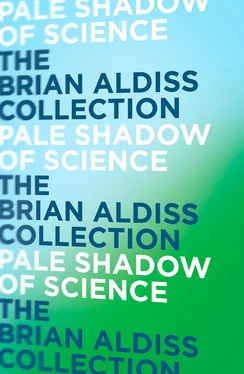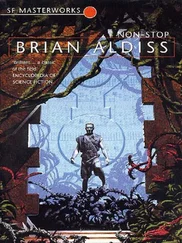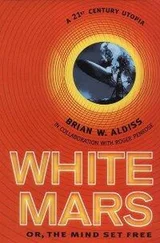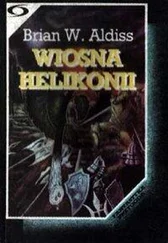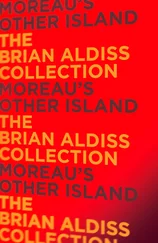Brian Aldiss - Pale Shadow of Science
Здесь есть возможность читать онлайн «Brian Aldiss - Pale Shadow of Science» — ознакомительный отрывок электронной книги совершенно бесплатно, а после прочтения отрывка купить полную версию. В некоторых случаях можно слушать аудио, скачать через торрент в формате fb2 и присутствует краткое содержание. Жанр: unrecognised, на английском языке. Описание произведения, (предисловие) а так же отзывы посетителей доступны на портале библиотеки ЛибКат.
- Название:Pale Shadow of Science
- Автор:
- Жанр:
- Год:неизвестен
- ISBN:нет данных
- Рейтинг книги:5 / 5. Голосов: 1
-
Избранное:Добавить в избранное
- Отзывы:
-
Ваша оценка:
- 100
- 1
- 2
- 3
- 4
- 5
Pale Shadow of Science: краткое содержание, описание и аннотация
Предлагаем к чтению аннотацию, описание, краткое содержание или предисловие (зависит от того, что написал сам автор книги «Pale Shadow of Science»). Если вы не нашли необходимую информацию о книге — напишите в комментариях, мы постараемся отыскать её.
Pale Shadow of Science — читать онлайн ознакомительный отрывок
Ниже представлен текст книги, разбитый по страницам. Система сохранения места последней прочитанной страницы, позволяет с удобством читать онлайн бесплатно книгу «Pale Shadow of Science», без необходимости каждый раз заново искать на чём Вы остановились. Поставьте закладку, и сможете в любой момент перейти на страницу, на которой закончили чтение.
Интервал:
Закладка:
As Muriel Spark says, Mary in her thinking seems at least fifty years ahead of her time. [9]She discovered the Irrational, one of the delights and torments of our age. By dressing it in rational garb, and letting it stalk the land, she unwittingly dealt a blow against the tradition to which Mercier was heir. Utopia is no place for the irrational.
Other arguments for the seminal qualities of Frankenstein are set out more fully in Billion Year Spree , for those interested. In sum, Victor Frankenstein is a modern, consciously rejecting ancient fustian booklore in favour of modern science, kicking out father figures. His creation of life shows him further usurping paternal power, invading what was previously God’s province – the role medicine has played since Jenner’s smallpox vaccine. Victor and his monster together function as the light and dark side of mankind, in a symbolism that was to become increasingly comprehensible after Mary’s death.
As befitted an author writing after the Napoleonic Wars, when the Industrial Revolution was well under way, Mary deals, not merely with extrapolated development like Mercier before her, but with unexpected change, like Wells after her. Above all, Frankenstein stands as the figure of the scientist (though the word was not coined when Mary wrote), set apart from the rest of society, unable to control the new forces he has brought into the world. The successor to Prometheus is Pandora. No other writer, except H. G. Wells, presents us with as many innovations as Mary Shelley.
The Last Man was published in 1826, anonymously, as Frankenstein had been. Few critics of standing have praised the novel. It meanders. Muriel Spark, however, said of it that it is Mary’s ‘most interesting, if not her most consummate, work.’
The theme of The Last Man was not new, and could hardly be at a time when epidemics were still commonplace. The title was used for an anonymous novel in 1806. Thomas Campbell wrote a poem with the same title; whilst at the Villa Diodati, Byron composed a poem entitled ‘Darkness’ in which the world is destroyed and two men, the last, die of fright at the sight of each other. In the same year that Mary’s novel was published, John Martin painted a water-colour on the subject (later, in 1849, he exhibited a powerful oil with the same title).
The novel is set in the twenty-first century, a period, it seems, of much sentimental rhetoric. Adrian, Earl of Windsor, befriends the wild Lionel Verney. Adrian is the son of the King of England, who abdicated; one of the King’s favourites was Verney’s father. Adrian is full of fine sentiments, and wins over Verney. Verney has a sister called Perdita who falls in love with Lord Raymond, and eventually commits suicide. Raymond is a peer of genius and beauty who besieges Constantinople. The relationships of these personages, together with a profusion of mothers and sisters, fill the first of the three volumes. Adrian is Mary’s portrait of Shelley, the bright rather than the dark side, Perdita is Claire, Raymond Byron. Verney plays the part of Mary, and eventually becomes the Last Man. Verney, like Frankenstein, is a paradigm of the Outsider.
There is undoubted strength in the second and third books, once the plague has the world in its grip. Society disintegrates on a scale merely hinted at in the unjust world of Frankenstein . ‘I spread the whole earth out as a map before me. On no one spot of its surface could I put my finger and say, here is safety. In the south, the disease, virulent and immedicable, had nearly annihilated the race of man; storm and inundation, poisonous winds and blights, filled up the measure of suffering. In the north it was worse ….’
Finally, Verney-Mary alone is left, drifting south towards the equator, like a character in a J.G. Ballard novel. So Mary tells us how life was without Shelley; her universe had gone. Through science fiction, she expressed her powerfully inexpressible feelings.
In his brief book on Mary, [10]William Walling makes a point which incidentally relates The Last Man still more closely to the science-fictional temper. Remarking that solitude is a common topic of the period and by no means Mary’s monopoly, Walling claims that by interweaving the themes of isolation and the end of civilization, she creates a prophetic account of modern industrial society, in which the creative personality becomes more and more alienated.
Tales and Stories by Mary Shelley were collected together by Richard Garnett and published in 1891. They are in the main conventional. Familial and amorous misunderstandings fill the foreground, armies gallop about in the background. The characters are high-born, their speeches high-flown. Tears are scalding, years long, sentiments either villainous or irreproachable, deaths copious and conclusions not unusually full of well-mannered melancholy. The tales are of their time. Here again, the game of detecting autobiographical traces can be played. One story, ‘Transformation,’ sheds light on Frankenstein – but not much. We have to value Mary Shelley, as we do other authors, for her strongest work, not her weakest; and her best has a strength still not widely enough appreciated.
This collection of stories from scattered journals and keepsake albums indicates Mary’s emotional and physical exhaustion. In the course of eight years, between 1814 and 1822, she had borne four children, three of whom died during the period, and had suffered miscarriages. She had travelled hither and thither with her irresponsible husband, who had most probably had an affair with her closest friend, Claire. And she had witnessed suicides and death all round her, culminating in Shelley’s death. It was much for a sensitive and intellectual woman to endure. No wonder that Claire Clairmont wrote to her, some years after the fury and shouting died, and said, ‘I think in certain things you are the most daring woman I ever knew.’ [11]
1. An enjoyable recent biography is Jane Dunn’s Moon in Eclipse: A Life of Mary Shelley, 1979.
2. One thinks here of the scene after Shelley’s death, when Trelawny caused his corpse to be burnt on the shore, Byron and Leigh Hunt also being present. At the last possible moment, Trelawny ran forward and snatched Shelley’s heart from the body.
3. David Ketterer, Frankenstein’s Creation: The Book, The Monster, and Human Reality, University of Victoria, 1979.
4. Leonard Wolf, The Annotated Frankenstein, 1977.
5. David Ketterer, ‘Frankenstein in Wolf’s Clothing,’ Science Fiction Studies, No. 18, July 1979.
6. Christopher Small, Ariel Like a Harpy, 1972.
7. Brian Aldiss, Billion Year Spree, 1973.
8. Ellen Moers, ‘Female Gothic: The Monster’s Mother,’ The New York Review, 21 March 1974, reprinted in Literary Women, 1976.
9. Muriel Spark, Child of Light: A Reassessment of Mary Wollstonecraft Shelley, 1951. *A biographer of Mary Shelley, writing in the nineteen-thirties, advances the argument that Frankenstein is ‘the first of the Scientific Romances that have culminated in our day in the work of Mr. H. G. Wells,’ because it erects ‘a superstructure of fantasy on a foundation of circumstantial “scientific fact.”’ Shrewd judgement, although the excellence of the novel is otherwise underestimated. (R. Glynn Grylls: Mary Shelley, A Biography, 1938.)
10. 9 William Walling: Mary Shelley, 1972.
11. Claire Clairmont, letter, quoted in Julian Marshall’s Life and Letters of Mary Wollstonecraft Shelley, 1889.
The Immanent Will Returns The Immanent Will Returns The Downward Journey: Orwell’s 1984 A Whole New Can of Worms Peep A Transatlantic Harrison, Yippee! The Atheist’s Tragedy Revisited The Pale Shadow of Science A Monster for All Seasons Helliconia: How and Why Bold Towers, Shadowed Streets … … And the Lurid Glare of the Comet When the Future Had to Stop What Happens Next? Grounded in Stellar Art It Takes Two to Tango Robert Sheckley’s World: Australia Sturgeon: Mercury Plus X The Glass Forest About the Author Also available by the author Also part of The Brian Aldiss Collection Copyright Конец ознакомительного фрагмента. Текст предоставлен ООО «ЛитРес». Прочитайте эту книгу целиком, купив полную легальную версию на ЛитРес. Безопасно оплатить книгу можно банковской картой Visa, MasterCard, Maestro, со счета мобильного телефона, с платежного терминала, в салоне МТС или Связной, через PayPal, WebMoney, Яндекс.Деньги, QIWI Кошелек, бонусными картами или другим удобным Вам способом. About the Publisher
Интервал:
Закладка:
Похожие книги на «Pale Shadow of Science»
Представляем Вашему вниманию похожие книги на «Pale Shadow of Science» списком для выбора. Мы отобрали схожую по названию и смыслу литературу в надежде предоставить читателям больше вариантов отыскать новые, интересные, ещё непрочитанные произведения.
Обсуждение, отзывы о книге «Pale Shadow of Science» и просто собственные мнения читателей. Оставьте ваши комментарии, напишите, что Вы думаете о произведении, его смысле или главных героях. Укажите что конкретно понравилось, а что нет, и почему Вы так считаете.
